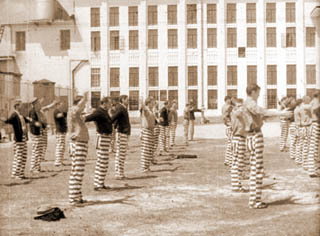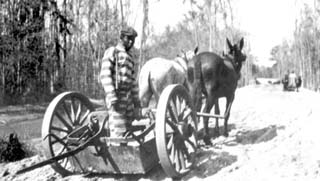1929
INMATE POPULATION DECEMBER 31, 1929: 2,600
The following is from a letter written by Supervisor of State Convicts B.H. Dickson to the Honorable Nathan Mayo, Commissioner of Agriculture, dated January 24, 1929 from Marianna, Florida (from the Twentieth Biennial Report of the Prison Division of the Department of Agriculture of the State of Florida for the years 1927 and 1928).
LETTER FROM B.H. DICKSON TO NATHAN MAYO
Dear Sir:
Paying inmates for working...
Complying with your request for a report from me as to how I find the prison conditions in general, I am glad to state that I have observed a considerable improvement in the general working condition and morale of the State convicts in my division during the last two years. I, therefore, have very few suggestions to make that I think would improve the present conditions. However, I believe if the convicts were paid a small compensation, say $1.00 at the end of each month, when their work and general conduct warranted it (the Captain in charge to be the judge) that it would stimulate the men to work better and conduct themselves in a better way, and that the additional work and grade of work done would more than compensate the State for this additional expense. I believe this would be very effective, especially with the negro convicts.
Providing a bigger stipend upon release...
I note that when a State convict is released he is only paid $10.00 and out of this amount he is forced to buy a suit of civilian clothes and pay his transportation back to his home. I think that his amount should be doubled at least. When the State works a man from five to twenty years and sometimes longer, and then turns him loose in the world penniless, and in most cases many miles from his home and friends, it naturally has a tendency to induce him to continue his life of crime. If he doesn't succeed in getting employment immediately after his release, he will be forced to steal or starve, which in a way will make the State a party to the crime. It is not always easy for a convict to secure employment as soon as he is released.
Eliminate iron cages on wheels...
In reference to county convicts, I would recommend that the portable vans (iron cages on wheels) now used by a good many of the counties for sleeping quarters for the convicts be abolished. These old cages are unsanitary, uncomfortable, unhealthy and in every way undesirable. They are close and stuffy and men are required to sleep on shelf cots from two to three deep on both sides of the van with hardly room enough to pass between. It is impossible to provide any place in these vans for the men to take a bath, and it is a difficult matter to keep these cages clear of vermin. The counties that work their convicts should be required to build permanent barracks in some centrally located place in the county and take the men to and from their work in trucks. In doing so, they would be able to work their No. 2 prisoners to an advantage by maintaining a garden at all times, which would greatly reduce the food bill and at the same time keep the men healthy and in a better working condition.
Yours very truly,
B.H. Dickson,
Supervisor of State Convicts

Metal cage for inmates
Today's inmates are paid for their work if they work for the prison industries program PRIDE (Prison Rehabilitative Industries and Diversified Enterprises). They may work in the canteens, as barbers, during work release, and in a few other areas. They are given up to $100 (depending on pending charges, how much money they have in their inmate account, community resources available to them, etc.) when they leave prison, some "civilian clothes," and a bus ticket to their chosen destination. The standard gratuity is $50.00, but the amount can be doubled if the inmate lacks employment, residence and income in the community. They are also given some assistance upon release, which may include employment, substance use treatment, mental health treatment, education, etc.
Road prisons eventually replace the "iron cages on wheels" when the first one opens in 1941.
BRADFORD COUNTY TELEGRAPH
29 MARCH 1929
Old Man Florida seems to be somewhat of a farmer, himself. Just noticed that he has a state farm at Raiford with 18,000 acres, 15,000 of it under fence, 2,000 acres under cultivation, 1,000 acres in horticulture, 1,200 head of Jersey, Angus and grade cattle, 600 head of hogs, 3,000 laying hens, 100 head of mules and horses, with a list of products indicating that the farm is well managed. This is the state's prison farm. Some place of business. Arcadia Arcadian.
FLORIDA TIMES UNION INDEX
21 APRIL 1929, IV 9 3
Mrs. J. S. BLITCH entertained with dinner party honoring J. S. BLITCH, supt. of State Farm.
1931
INMATE POPULATION DECEMBER 31, 1931: 2,895
The following is a letter written by Attorney General Gary D. Landis to the Honorable J. S. Blitch, dated June 1, 1931, regarding the official role of the executioner, and delegation of those duties.
| GARY D. LANDIS ATTORNEY GENERAL |
STATE OF FLORIDA |
H.E. CARTER ALLIE YAWN BROWN EVELYN DAVIS |
Hon. J. S. Blitch, Supt., My dear Mr. Blitch: Replying to your favor of the 29th. ultimo, I beg to advise that it is not my purpose to change the opinion rendered by my predecessor, Honorable Fred H. Davis, relative to your being the official executioner as by virtue of your position as Superintendent of the State Prison. It is my opinion that you are the official executioner and that the Sheriff of the county wherein a prisoner is convicted is ex officio deputy executioner and that you have the right to allocate to such deputy executioner the performance of the duty of throwing the switch on the electric chair, or such other matters as pertain to the execution. I do not believe that Sheriff Lewis has talked with me, but he may have talked with one of my assistants, but I feel sure that he must have misunderstood any one who may have talked with him in this office. Trusting that this gives you the desired information and assuring you that you may be at ease as to my ruling in the matter, I beg to be Very respectfully yours, GARY D. LANDIS, |
||
One month after his release, Clarence Martin begins his 5th incarceration at age 30. He is sentenced to the State Prison in Raiford. On June 23, 1931 he escapes from prison and is captured the same day. The photo below was taken on June 22, 1938 when Clarence is 37 years old.
 |
|

Raiford prison inmates exercise in the prison yard. (Photo courtesy of FPC.)

Inmate working on a Tallahassee road in 1930. (Photo courtesy of FPC.)
- 1821-1845
- 1868-1876
- 1877-1895
- 1900-1919
- 1921
- 1922-1924
- 1927
- 1928-1931
- 1932 | CHAPMAN
- 1933-1935
- 1936-1939
- 1940-1945
- 1946-1949
- 1950-1955
- 1956-1961
- 1962 | WAINWRIGHT
- 1963-1965
- 1966-1969
- 1970-1975
- 1976-1979
- 1980-1986
- 1987 | DUGGER
- 1988-1990
- 1991 | SINGLETARY
- 1992-1995
- 1996-1998
- 1999 | MOORE
- 2000-2002
- 2003 | CROSBY
- 2004-2005
- 2006 | MCDONOUGH
- 2007
- 2008 | MCNEIL
- 2009-2010
- 2011 | BUSS
- 2011 | TUCKER
- 2012 | CREWS
- 2013-2014
- 2014 | JONES
- 2015-2018
- 2019 | INCH
- 2020-2021
- 2021 | DIXON
- 2022-Today
- Population Summary Table

